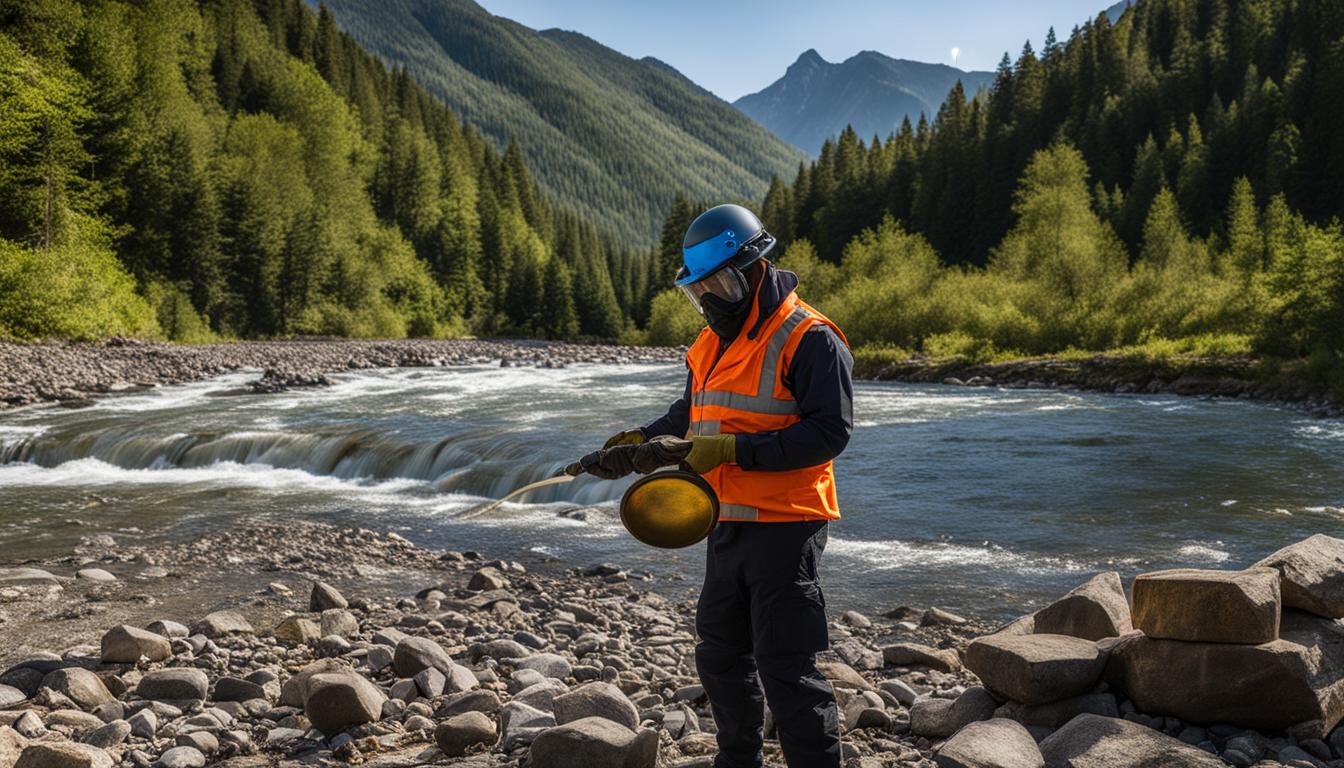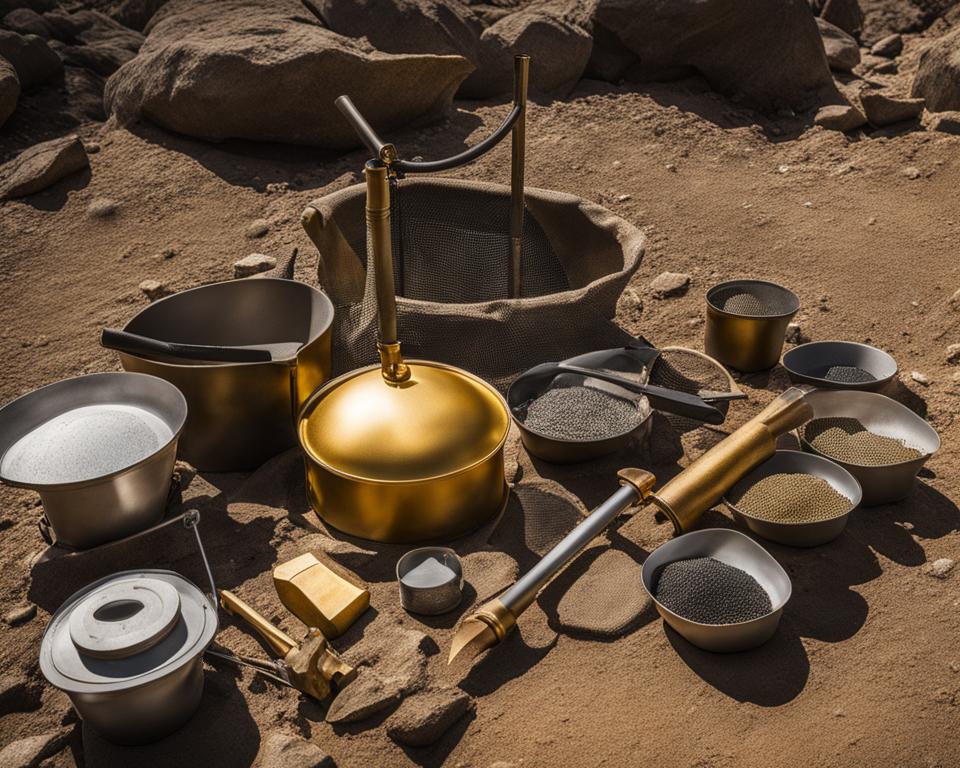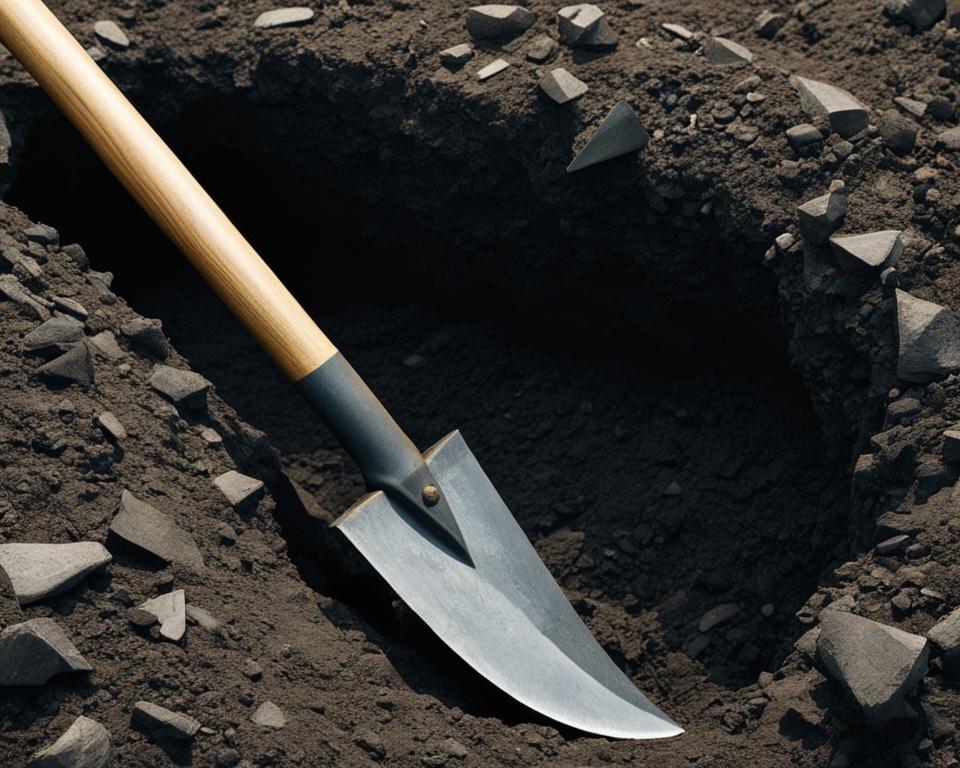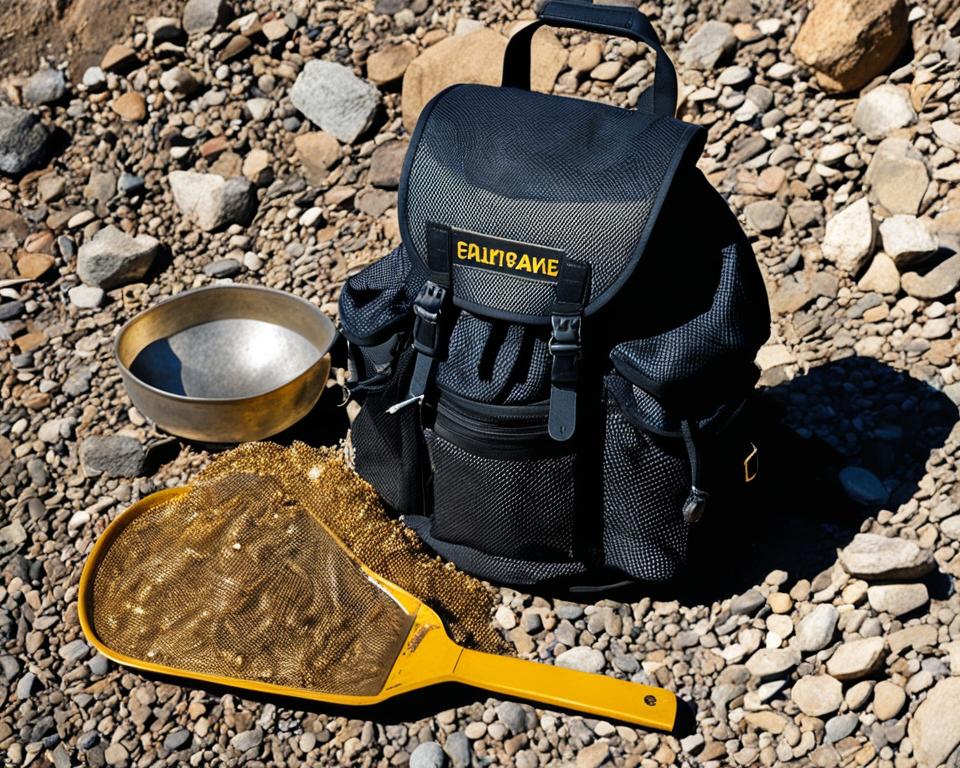
Portable gold processing plants have revolutionized the way gold is processed, offering mobile and efficient solutions for gold recovery. These plants are designed to be portable, allowing for easy transportation and setup at different mining sites. They provide a cost-effective method for processing gold ores and are particularly beneficial for small-scale mining operations. In this article, we will explore the advantages and features of portable gold processing plants.
Key Takeaways:
- Portable gold processing plants offer mobile and efficient solutions for processing gold ores.
- They are designed to be portable, allowing for easy transportation and setup at different mining sites.
- These plants are cost-effective and particularly beneficial for small-scale mining operations.
- Portable gold processing plants utilize various equipment such as crushers, ball mills, shaking tables, and leaching tanks.
- Gravity concentration and flotation are commonly used methods in portable gold processing plants.
What is a Portable Gold Processing Plant?
A portable gold processing plant is a compact and self-contained system that is designed to process gold ores. It consists of various equipment such as crushers, ball mills, shaking tables, centrifuges, and leaching tanks. These components work together to crush, grind, and extract gold from the ore, making it easier and more efficient for miners to obtain valuable gold.
Portable gold processing plants are specifically designed to be mobile, allowing them to be easily transported to different mining sites. This mobility provides miners with the flexibility to conduct on-site processing of gold ores, minimizing the need for costly transportation and logistics.
The equipment used in portable gold processing plants is carefully selected to ensure efficient and effective operations. Crushers are used to break down large rocks and ore into smaller particles, while ball mills are employed to grind the ore into a fine powder. Shaking tables and centrifuges are utilized to separate gold particles from other minerals, and leaching tanks aid in the extraction of gold through specialized chemical processes.
By utilizing portable gold processing plants, miners can optimize their operations by reducing costs, increasing productivity, and improving the overall efficiency of gold processing.
Advantages of Portable Gold Processing Plants
Portable gold processing plants offer several advantages for small-scale miners and mining operations. These plants provide cost-effective and efficient solutions for processing gold ores, enabling miners to maximize their profits. Let’s explore the key advantages of these portable plants:
- Affordable for Small-Scale Miners: Portable gold processing plants have a low initial cost compared to permanent mill installations. This affordability makes them more accessible to small-scale miners, enabling them to embark on gold mining projects with lower capital investments.
- Flexibility and Mobility: Unlike permanent mill installations, portable gold processing plants can be easily transported from one location to another. This flexibility allows miners to set up the plants at different mining sites, eliminating the need for multiple fixed infrastructure. It also enables miners to quickly move operations to areas with higher gold yield.
- Processing Isolated Ore Deposits: Portable gold processing plants are particularly useful for processing isolated ore deposits that may not warrant the construction of permanent mill installations. These plants can be quickly deployed to remote areas, allowing miners to extract gold from these deposits without incurring significant infrastructure costs.
- Opportunity for Testing and Pilot Plants: Portable gold processing plants also provide the opportunity for miners to conduct testing and pilot plants for large-scale installations. This allows miners to optimize their extraction and processing methods before investing in larger facilities, reducing the risk of operational inefficiencies.
To illustrate the advantages visually, here’s a table summarizing the key points:
| Advantages |
|---|
| Affordable for Small-Scale Miners |
| Flexibility and Mobility |
| Processing Isolated Ore Deposits |
| Opportunity for Testing and Pilot Plants |
In conclusion, portable gold processing plants offer numerous advantages for small-scale miners and mining operations. They provide a cost-effective and flexible solution for processing gold ores, enabling miners to extract gold efficiently and maximize their profits.
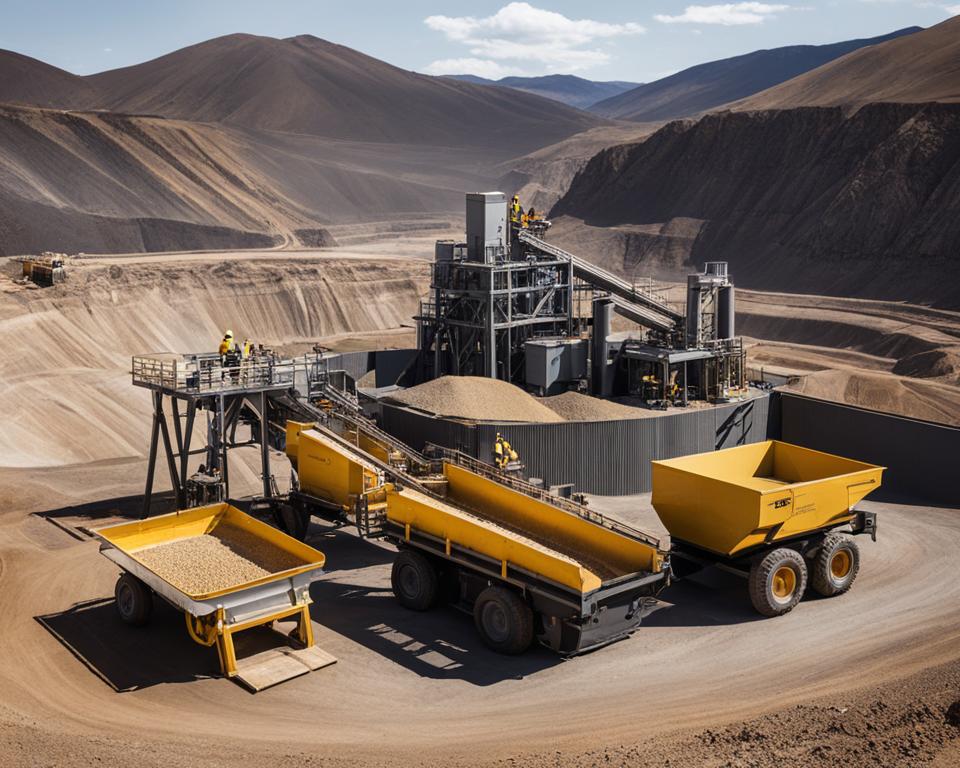
Equipment Used in Portable Gold Processing Plants
Portable gold processing plants utilize a range of equipment to optimize the extraction and processing of gold ores. By employing advanced technology and efficient machinery, these plants ensure the maximum recovery of gold from various types of ores.
The primary equipment used in portable gold processing plants include:
- Crushers: Crushers are used to break down large rocks and ores into smaller, manageable pieces. This initial crushing process is crucial in preparing the ore for further processing.
- Ball Mills: Ball mills are utilized for grinding the ore into a fine powder. This step is essential to extract the gold particles more efficiently and effectively.
- Shaking Tables: Shaking tables are used for the separation of gold particles from other minerals. They utilize the principle of density-based separation to concentrate the gold.
- Centrifugal Concentrators: Centrifugal concentrators further enhance the concentration of gold in the ore. They utilize centrifugal force to separate gold particles from other materials.
- Leaching Tanks: Leaching tanks are vital for the chemical extraction of gold from the ore. Specialized chemicals are added to the tanks, allowing for the dissolution of gold particles.
Depending on the specific processing requirements, other equipment such as portable gold trommels, gold wash plants, and portable gold concentrators may also be used.
Portable gold trommels are efficient and versatile screening machines that enable the separation of different sizes of gold particles. They are particularly useful for preliminary screening of ores before further processing.
Gold wash plants, on the other hand, are designed to remove impurities and enhance the quality of gold ores. These plants utilize water and mechanical agitation to clean and process the ore before extraction.
Portable gold concentrators are compact devices that help optimize the recovery of gold from various types of ores. They are versatile and can process both coarse and fine gold particles efficiently.
Overall, the equipment used in portable gold processing plants ensures that gold recovery is maximized, allowing for efficient and cost-effective processing of gold ores.
Gravity Concentration in Gold Extraction
Gravity concentration is a commonly used method in gold ore separation. It harnesses the natural force of gravity to separate gold particles from other minerals based on their different densities and settling velocities. This technique is particularly effective for placer gold ore and can yield positive results in large-scale and medium-sized rock gold mines with disseminated grain sizes. Portable gold processing plants often utilize gravity concentrators such as mineral jigs, shakers, sluice boxes, and centrifugal concentrators to achieve efficient and cost-effective gold extraction through gravity concentration.
Placer gold ore, which consists of loose particles that have been eroded from their original sources and deposited by water, is well-suited for gravity concentration. The principle behind gravity concentration is simple: heavier particles settle faster than lighter particles due to gravity’s pull. By utilizing specially designed equipment, gold particles can be separated and collected, resulting in a higher concentration of gold and reduced processing costs.
Gravity Concentration Equipment
The following table provides an overview of common gravity concentration equipment used in portable gold processing plants:
| Equipment | Description |
|---|---|
| Mineral Jigs | Uses pulsating water flow and gravity to separate gold from other minerals |
| Shakers | Applies shaking motion to separate gold particles based on their weight and size |
| Sluice Boxes | Utilizes a series of inclined channels to trap gold particles while allowing lighter materials to wash away |
| Centrifugal Concentrators | Employs centrifugal force to enhance the gravity separation of gold from other minerals |

In the words of John Smith, a renowned mining engineer, “Gravity concentration is an essential component of the gold extraction process. Its simplicity and effectiveness make it a valuable technique for maximizing gold recovery.”
By incorporating gravity concentration into the gold extraction process, portable gold processing plants can efficiently recover gold while minimizing the use of chemicals and energy-intensive procedures. Additionally, gravity concentration enables the processing of lower-grade ores that might not be economically viable using other methods. This makes gravity concentration a key technique in the arsenal of gold extraction methods employed by modern mining operations.
Flotation in Gold Extraction
Flotation is another effective method used in gold ore separation. It is based on the difference in surface hydrophobicity of different minerals, allowing for the separation of sulfide gold ore. By selectively attaching air bubbles to the valuable minerals, the sulfide gold ore can be separated from other minerals present in the ore.
However, it’s important to note that the separation effect of oxidized gold ore through flotation is not as good. Oxidized gold ore contains minerals that have been altered by weathering processes, making the flotation process less efficient.
Flotation is a complex process that requires high equipment investment and entails potential environmental pollution due to the use of chemicals. Therefore, it is commonly employed in large-scale gold processing plants that have the necessary resources and environment-friendly measures to handle the process effectively.
In this method, the sulfide gold ore is first ground into a fine powder. Then, the ground ore is mixed with water and flotation reagents, which help to create air bubbles and facilitate the attachment of the gold particles to these bubbles. The gold-bearing bubbles rise to the surface and form a froth, where they are collected and further processed to obtain the gold concentrate.
Despite its complexities, flotation remains a significant gold extraction method, especially for sulfide gold ores. Its application in large-scale processing plants ensures efficient recovery and maximum extraction of gold from the ore.
The Flotation Process
- Grinding: The sulfide gold ore is ground into a fine powder to increase the surface area for flotation.
- Mixing: The ground ore is mixed with water and flotation reagents, which promote the attachment of gold particles to air bubbles.
- Flotation: The mixture is agitated to create a frothy layer where the gold-bearing bubbles are collected.
- Concentrate: The collected froth containing the gold concentrate is further processed to separate the gold from other minerals.
Advantages of Flotation in Gold Extraction
“Flotation offers a selective method to separate sulfide gold ores from other minerals, allowing for efficient gold recovery. It is widely utilized in large-scale gold processing plants to maximize gold extraction from valuable ore deposits.” – Gold Processing Expert
Cyanide Leaching in Gold Extraction
Cyanide leaching is a widely used method for gold extraction. It involves using cyanide to produce electrochemical corrosion of gold and silver in the ore, forming a leaching solution that can be further processed to recover gold and silver.
However, cyanide is highly toxic and can cause serious environmental pollution. As a result, some countries restrict the use of cyanide leaching in small and medium-scale mineral processing enterprises. Only large gold processing plants equipped with pollution control equipment can use this method.
Cyanide leaching is an efficient method for gold extraction, but its environmental impact and potential health risks make it a controversial choice. As a result, researchers and engineers are constantly exploring alternative methods to minimize the use of cyanide in gold extraction processes.
The Process of Cyanide Leaching
In cyanide leaching, crushed and ground gold ore is mixed with water and a weak cyanide solution. The gold particles react with the cyanide to form a soluble complex, which can then be easily separated from the ore. The gold can be further recovered from the leaching solution through various methods, such as electrowinning or precipitation with zinc.
The use of cyanide in gold extraction has revolutionized the mining industry, enabling the efficient recovery of gold from low-grade and complex ores. However, it is crucial to ensure proper handling, storage, and disposal of cyanide to prevent environmental contamination.
Environmental Impact and Safety Concerns
While cyanide leaching is effective in extracting gold, its toxicity raises concerns about its impact on human health and the environment. Cyanide can pose risks to aquatic life, contaminate water sources, and have adverse effects on ecosystems.
As a result, strict regulations and safety measures are in place to ensure the responsible use of cyanide in gold extraction. Large-scale gold processing plants are equipped with advanced pollution control technologies, such as detoxification systems and containment ponds, to prevent cyanide leakage and minimize environmental impact.
Alternatives to Cyanide Leaching
In recent years, several alternative methods have been developed and researched to reduce the reliance on cyanide in gold extraction. These methods include:
- Thiosulfate leaching: Thiosulfate is a non-toxic alternative to cyanide and can effectively extract gold from ores.
- Ammonia-cyanide leaching: Ammonia-cyanide solutions can be used as a less toxic alternative to traditional cyanide leaching.
- Biological leaching: Microorganisms can be used to facilitate gold extraction by oxidation of sulfide minerals.
Research efforts continue to explore and develop alternative gold extraction methods that are more environmentally friendly and socially responsible.
| Extraction Method | Advantages | Disadvantages |
|---|---|---|
| Cyanide Leaching | – High gold recovery rates – Well-established and efficient process |
– Toxic and hazardous – Environmental concerns |
| Thiosulfate Leaching | – Non-toxic alternative – Less impact on the environment |
– Lower gold recovery rates compared to cyanide leaching |
| Ammonia-Cyanide Leaching | – Less toxic than cyanide – Effective for certain types of ores |
– More complex process – Higher cost compared to cyanide leaching |
| Biological Leaching | – Environmentally friendly – Can be used for refractory ores |
– Slower extraction rates – Requires specialized knowledge and equipment |
Portable Gold Processing Plants in Tanzania
Tanzania, one of the leading gold-producing countries in Africa, has garnered considerable attention from both local and international investors. The nation’s abundant gold reserves and the upward trajectory of gold prices have made small-scale gold mining projects in Tanzania increasingly attractive. In this endeavor, portable gold processing plants have emerged as key tools for extracting gold while simultaneously providing sustainable livelihoods for local communities. These plants play a pivotal role in driving regional economic growth and promoting environmental conservation.
With the advancement of portable gold processing technology, small-scale gold mining in Tanzania has undergone a transformative shift. These plants offer efficient and adaptable solutions that cater to the specific needs of the sector. By incorporating state-of-the-art equipment and innovative processes, they enable miners to extract gold from remote locations without the need for extensive infrastructure.
Small-scale gold mining projects in Tanzania benefit greatly from the utilization of portable gold processing plants. These plants have revolutionized the industry by providing cost-effective and environmentally sustainable methods for extracting gold. Through their adoption, local communities are empowered and the enduring value of Tanzania’s gold reserves is unlocked.
Portable gold processing plants have become a crucial component of Tanzania’s mining landscape. They facilitate the growth of small-scale mining operations, allowing miners to efficiently extract gold from ore deposits that were previously considered economically unviable. By leveraging the portability and adaptability of these plants, the mining industry in Tanzania has experienced renewed vigor and rejuvenation.
Benefits of Portable Gold Processing Plants in Tanzania
The emergence of portable gold processing plants in Tanzania has brought forth numerous benefits. Here are some of the key advantages:
- Enhanced Efficiency: Portable gold processing plants streamline the gold extraction process, resulting in improved efficiency and higher yields. Miners can process larger quantities of ore with greater precision, allowing them to maximize their gold recovery.
- Cost-Effectiveness: These plants offer a cost-effective alternative to traditional mining methods. The lower initial investment and operational expenses make them particularly suitable for small-scale mining operations in Tanzania.
- Sustainable Livelihoods: The utilization of portable gold processing plants has a positive impact on local communities. By creating employment opportunities and supporting the development of small businesses, these plants contribute to the socio-economic growth of the region.
- Environmental Conservation: Portable gold processing plants prioritize environmental sustainability through their efficient use of resources and adoption of eco-friendly practices. They minimize the ecological footprint associated with traditional mining processes, ensuring the long-term preservation of Tanzania’s natural habitats.
Through the deployment of portable gold processing plants, Tanzania is bolstering its position in the global gold mining industry. By harnessing the nation’s immense gold reserves, small-scale mining operations are thriving, while simultaneously promoting responsible mining practices and social development.
| Gold Production | Gold Reserves | Importance for Tanzania |
|---|---|---|
| Top gold-producing country in Africa | Abundant gold reserves | Significant economic contribution |
| Highly sought-after investment destination | Untapped potential for further exploration | Job creation and local empowerment |
| Driving force behind Tanzania’s mining industry | Supports sustainable development initiatives | Environmental conservation and responsible mining practices |
Machinery for Small-Scale Gold Processing Plants in Tanzania
Small-scale gold processing plants in Tanzania rely on various machinery to optimize the extraction and processing of gold ores. These machines work together to ensure efficient and sustainable gold processing in the region.
Crushers
Crushers play a vital role in the gold processing process by breaking down large rocks and ore into smaller, manageable pieces. This enables further processing and extraction of gold particles from the ore.
Ball Mills
Ball mills are critical equipment in gold processing plants as they are responsible for grinding the ore to a fine powder. This finely ground ore is essential for extracting gold efficiently.
Shaking Tables and Centrifuges
Shaking tables and centrifuges are utilized to separate gold particles from other minerals in the ore. These machines rely on gravity and centrifugal force to achieve efficient separation, ensuring the purity of the extracted gold.
Leaching Tanks
Leaching tanks are crucial in the extraction process of gold. They facilitate the use of specialized chemicals that aid in the dissolution and extraction of gold from the ore. These tanks ensure the efficient and effective extraction of gold through chemical processes.
By employing this range of machinery, small-scale gold processing plants in Tanzania can optimize the extraction and processing of gold ores, leading to better yields and a more sustainable mining industry.
Usage Scenarios for Small-Scale Gold Processing Plants in Tanzania
Small-scale gold processing plants in Tanzania play a vital role in extracting and processing gold ores in regions abundant with gold deposits. These plants are strategically set up to optimize the efficient extraction of gold, ensuring a sustainable mining industry in the country.
Primary Processing
Primary processing is the initial stage where the extracted ore undergoes crushing and grinding to prepare it for further processing. Gold ores are crushed and ground into smaller particles, making it easier to extract the valuable gold content.
Secondary Processing
- Shaking Tables:
- Centrifuges:
Secondary processing focuses on enhancing the concentration of gold in the crushed ore. This stage involves the use of specialized equipment such as shaking tables and centrifuges.
Chemical Extraction
“Chemical extraction is a crucial step in gold processing, where leaching tanks and specialized chemicals are employed.”
In the final stage of gold extraction, leaching tanks are utilized along with specialized chemicals to separate gold from other minerals. This chemical extraction process enables the efficient recovery of gold from the ore, ensuring optimal yields.
With the involvement of primary processing, secondary processing, and chemical extraction, small-scale gold processing plants in Tanzania provide an integrated approach to recover gold efficiently from ore deposits. These scenarios ensure sustainable mining practices and contribute to the country’s economic development.
Contact Information for Small-Scale Gold Processing Plants in Tanzania
For those interested in exploring opportunities in Tanzania’s small-scale gold processing projects, contact us via WhatsApp at +8615515901102. We are happy to provide more details and assist you in this exciting venture. Investing in small-scale gold processing plants in Tanzania offers potential financial returns while positively contributing to local communities and the environment. It is a win-win situation for investors and the region, unlocking the full potential of Tanzania’s gold reserves.
Conclusion
Portable gold processing plants have revolutionized the gold mining industry by offering efficient and mobile solutions for processing gold ores. These plants provide numerous advantages, such as low initial cost, mobility, and flexibility. With their compact and self-contained systems, they can be easily transported and set up at different mining sites, making them ideal for small-scale mining operations and isolated ore deposits.
By utilizing various equipment such as crushers, ball mills, shaking tables, centrifuges, and leaching tanks, portable gold processing plants optimize gold extraction through different methods. Gravity concentration, flotation, and cyanide leaching are utilized to ensure efficient recovery of gold from the ore. The use of gravity concentration in portable gold processing plants allows for the separation of gold particles from other minerals based on their different settling velocities, while flotation is effective for the separation of sulfide gold ore. Cyanide leaching, though restricted in some areas due to its environmental implications, remains a widely used method for gold extraction.
In countries like Tanzania, small-scale gold processing plants are contributing to sustainable mining practices while fostering economic growth. These plants offer a cost-effective solution for local miners to process gold ores and unlock the potential of Tanzania’s gold reserves. If you’re interested in investing in efficient gold processing, contact us for more information on how portable gold processing plants can benefit your mining operations.
Source Links
- https://www.911metallurgist.com/blog/mini-portable-gold-processing-plant
- https://www.linkedin.com/pulse/beginners-guide-gold-extraction-methods-asa
- https://www.linkedin.com/pulse/small-gold-processing-plants-tanzania-shibang-group?trk=article-ssr-frontend-pulse_more-articles_related-content-card

Meet Ryan Conlon, the passionate owner and driving force behind Pan for Treasure.
With an unwavering love for the art of gold panning, Ryan has transformed his enthusiasm into a thriving community hub for fellow treasure seekers. [email protected]
A seasoned gold panning enthusiast, Ryan’s journey began with a simple pan and a dream, evolving into a deep appreciation for the history, geology, and thrill of uncovering precious metals.


